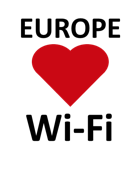Europe loves Wi-Fi: new EU study recommends more spectrum should be made available
(The primary author of the study is former FCC staffer J. Scott Marcus, now with Germany’s WIK Consult, who is not related to your blogger although we were friendly when we both worked down the hall from each other and while we both lived in Europe.)
It appears that the cellular establishment was behind the ill fated Section 104 of The Spectrum Innovation Act of 2011 that would have required an ill conceived unlicensed auction before FCC could create any additional unlicensed spectrum, even in ISM bands or above 100 GHz! However, the cellular establishment covered its tracks very well because no one ever spoke in public in favor of this odd provision. But since this provision appeared in a House committee staff memo written by a former CTIA staffer, it is a likely guess that CTIA was somehow behind it.
Here is the report summary from the EU website:
How is traffic off-loading evolving over time, both in terms of technical and of market developments, and how does this evolution influence the need for spectrum? It is widely recognized that traffic on the macro cellular network is growing rapidly, largely as a result of impressive take-up of smartphones and tablets. The surprising and little recognized reality is that, according to credible data captured from a range of sources, the visible growth in macro cellular mobile network traffic appears to be only the tip of a much larger iceberg. The volume of traffic that is already being off-loaded, chiefly to Wi-Fi in the home, already exceeds that of the mobile network, and can be expected to grow even faster as well. This is largely a result of the considerable effort that equipment vendors and standards bodies have invested in developing both Wi-Fi and cellular standards to improve interworking between the two and to optimise use of the available spectrum. Traffic off-load generates surprisingly large socio-economic benefits by virtue of the cost that MNOs have saved, or can be expected to save, by building a smaller network thanks to data traffic off-load. Relatively little action is needed at European level; however, a few interventions should be considered in order to ensure that the momentum is maintained. Among these are (1) seeking to make spectrum from 5150 MHz to 5925 MHz available globally for Wi Fi; (2) continue seeking to make 2.6 GHz and 3.5 GHz fully available for mobile use; (3) consulting on future licensing options for 3.5 GHz and other potential new licensed mobile frequency bands; and (4) various measures to reduce administrative burden on the deployment of public off-load services and networks.
Now the spectrum actions here are not really different from what the FCC is trying to do. But FCC seems too intimidated by the cellular establishment and their endless appetite for new spectrum to talk very visibly about this topic. However, snooping around the FCC website we did find this statement in an FCC blog in 2011 by John Leibovitz & Robert Alderfer:
Importantly, the (Cisco) report accounts for some offsetting effects, most notably the use of WiFi and femtocell networks to “offload” capacity from the mobile network to a fixed broadband connection. Cisco estimates that about 21% of traffic from smartphones and tablets was offloaded to WiFi or femtocells in 2010 and that this proportion will increase to 30% by 2015. This finding demonstrates the vital importance of unlicensed spectrum in helping address our nation’s wireless capacity needs. Still, overall traffic growth is likely to outpace offloading, according to Cisco’s forecast.
Also in 2011 Chmn. Genachowski said “Traffic offloading to WiFi helps reduce congestion that could otherwise impair the flow of data on commercial networks. WiFi and other innovations based on unlicensed spectrum have contributed hundreds of billions of dollars to our economy, and offer tremendous potential to foster economic growth and job creation.”

(Graphic from EU website)




![Validate my RSS feed [Valid RSS]](valid-rss-rogers.png)

